What color is Saturn? You’d think this question would be a no-brainer. You’ve been seeing pictures of Saturn and the other planets since you were a kid. You probably know it as the planet with the biggest ring system in the solar system. Maybe in Scouts, you earned an astronomy badge from looking at it and other planets through a telescope. If you’re a real science geek, you might even be able to name some of the spacecraft that have photographed it, including Voyager I and II. But ask people to tell what color Saturn is, and you’ll get answers all across the color wheel. That’s because so many false-color images of the planet have been published. Some of these serve a scientific purpose, to show temperature contrasts visually, or enhance details in clouds. Often, though, artists go crazy with their Photoshop and just recolor Saturn to create a dramatic work of art. In the end, it’s hard to remember what color Saturn really is. In this article, we’ll discover the color of Saturn, for real, along with some other facts about the planet you might not know. Let’s find out whether you’d be disappointed in the view if you traveled there and saw it with your own eyes.
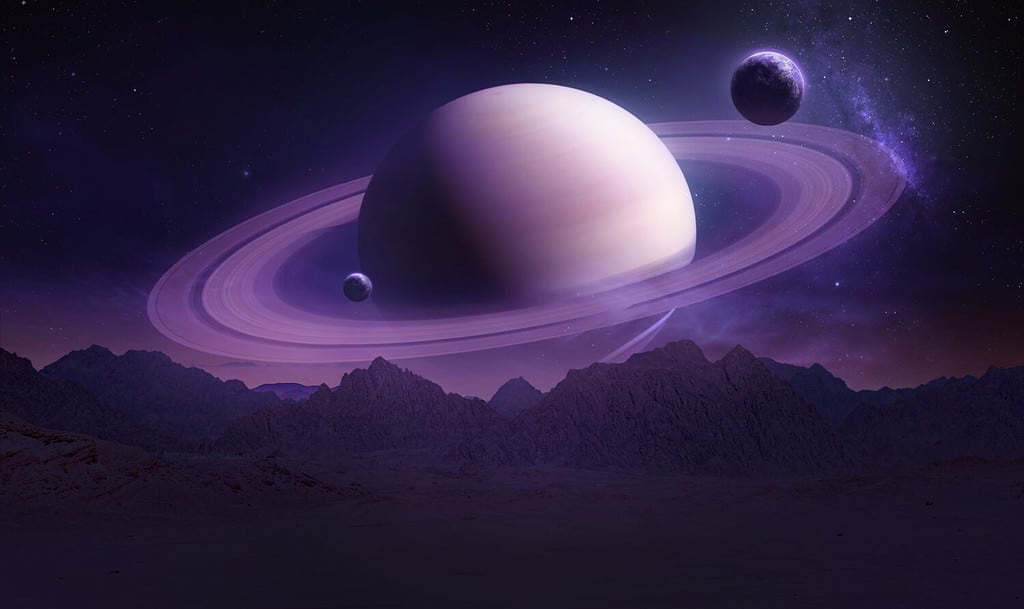
One thing’s for sure – this is not the color of Saturn!
©Dima Zel/Shutterstock.com
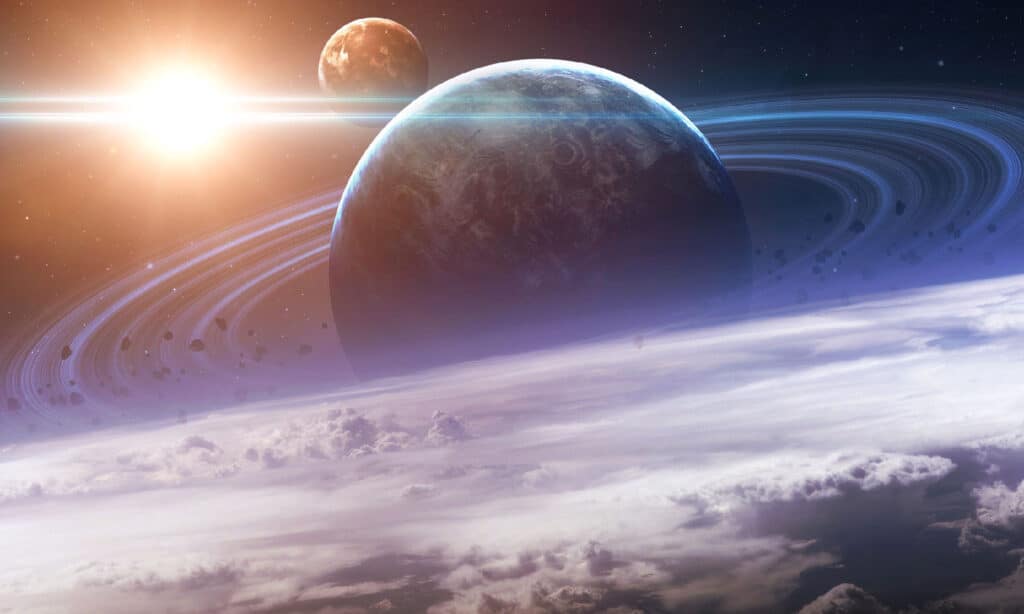
A fanciful depiction of Saturn as seen from one of its moons.
©iStock.com/forplayday
What’s Saturn Got to Do with Christmas?
Saturn was named for a significant Roman god that represented time, abundance, wealth, agriculture, renewal, and liberation. In mythology, he ruled during an era of peace and prosperity. The Greek equivalent of this god was Cronos. Among his children were Jupiter, Neptune, and Pluto. Romans celebrated this god in an annual festival in December known as Saturnalia that included gift-giving and wild, indulgent parties. When the Romans converted to Christianity, the Saturnalia holiday was replaced with Christmas. This isn’t all the acclaim that Saturn has gotten in Western culture. He’s also the namesake of Saturday, the most fun and restful day of the week!

The practice of giving gifts in December dates back to the Roman holiday Saturnalia, dedicated to their god Saturn.
©iStock.com/Firn
Saturn is Huge
Saturn is the 6th of our 8 planets from the Sun. The first four planets include Earth and the other three rocky or terrestrial planets. The last four, including Saturn, are giant planets or “gas giants” that are massive, have rocky cores, gigantic oceans of highly pressurized liquid gases, and thick atmospheres. The main elements in these planets are hydrogen and helium. Of the outer planets, Saturn is the second-largest after Jupiter. The two of them are so massive, they contain 92% of all the mass in the solar system, other than the Sun. The diameter of Saturn, not counting its rings, is over 9 times wider than Earth. Saturn rotates on its axis faster than Earth, so its days are a little less than 11 hours long. This fast spin causes the planet to bulge at the equator and be flatter at the poles. It takes longer than Earth to orbit the Sun, though, so one year on Saturn lasts 29 years on Earth.
Saturn’s Crazy Rings and Moons
All of that group have rings, but most are thin and difficult to see from Earth. Saturn’s rings are enormous and easily visible through good binoculars or a small telescope, though. They are made up of ice, rock, and dust and may be the result of collisions and destruction of primordial moons and captured asteroids of the planet. If Earth had rings like Saturn’s, they might look like a single thin bright line across the sky as seen from the Equator, or a band of rings that might look wider and lower in the sky the further you moved toward the poles. The rings might reflect sunlight all night long, making our nights more like twilight.
Gravity from Saturn’s 80+ moons, some of them called “shepherd moons,” helps keep the rings in definite paths with cleared spaces between, giving the rings the appearance of a vinyl record. Fantastically, some of the rings are even braided! A couple of Saturn’s more interesting moons are Titan, so large that it has its own atmosphere, and Mimas, a moon with an enormous crater that looks like an eye peering out into space. Scientists are interested in the moons of Saturn as possible places where extraterrestrial life may have developed and possible sites for future human colonization.
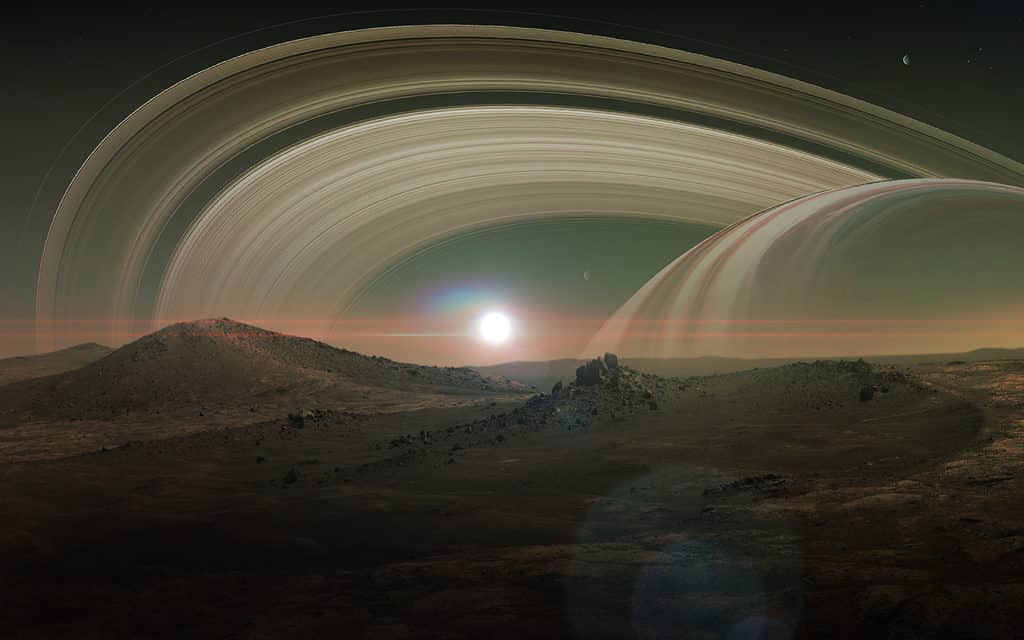
Artist’s conception of what Saturn might look like as seen from the surface of its moon, Titan, with the distant Sun rising behind Saturn’s rings.
©Vadim Sadovski/Shutterstock.com
What’s Inside Saturn?
Saturn’s Atmosphere
The atmosphere of Saturn is what we see in photos. It’s over 600 miles thick and made of hydrogen and helium with traces of ammonia, phosphine, water vapor, and hydrocarbons. This makes the actual color of Saturn we would see with the naked eye yellowish-brown.
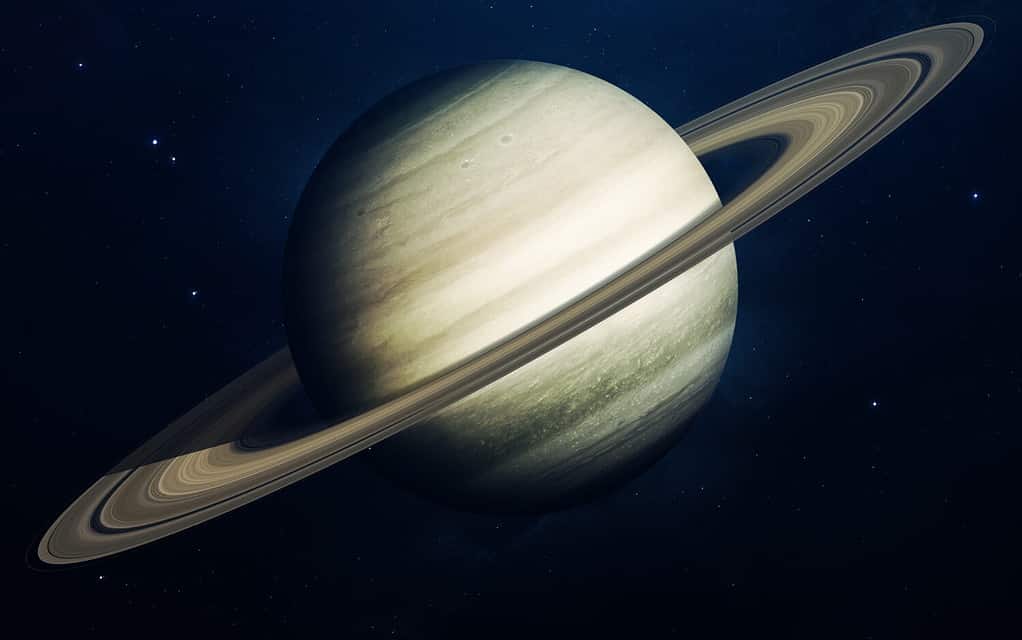
Saturn’s actual color as seen by the human eye is yellowish-brown due to the chemical composition of its upper atmosphere.
©Vadim Sadovski/Shutterstock.com
Saturn’s Interior
Further down, pressure and temperature change Saturn’s main elements, hydrogen and helium, into liquid form, and then still further, metallic form. The pressure of Saturn’s atmosphere is so great, some scientists believe it rains diamonds there! Beneath these gaseous, liquid, and metallic layers, researchers think Saturn has a solid core that may be 20 times the mass of the Earth. The core is extremely hot, as much as 21,000 °F! This is about 3.5 times hotter than the surface of the Sun! Saturn radiates more heat into space than it absorbs from the distant and dim Sun. An interesting fact about Saturn is that, overall it is 30% less dense than water, meaning if you could somehow create a bathtub big enough to test this theory out, Saturn would float!
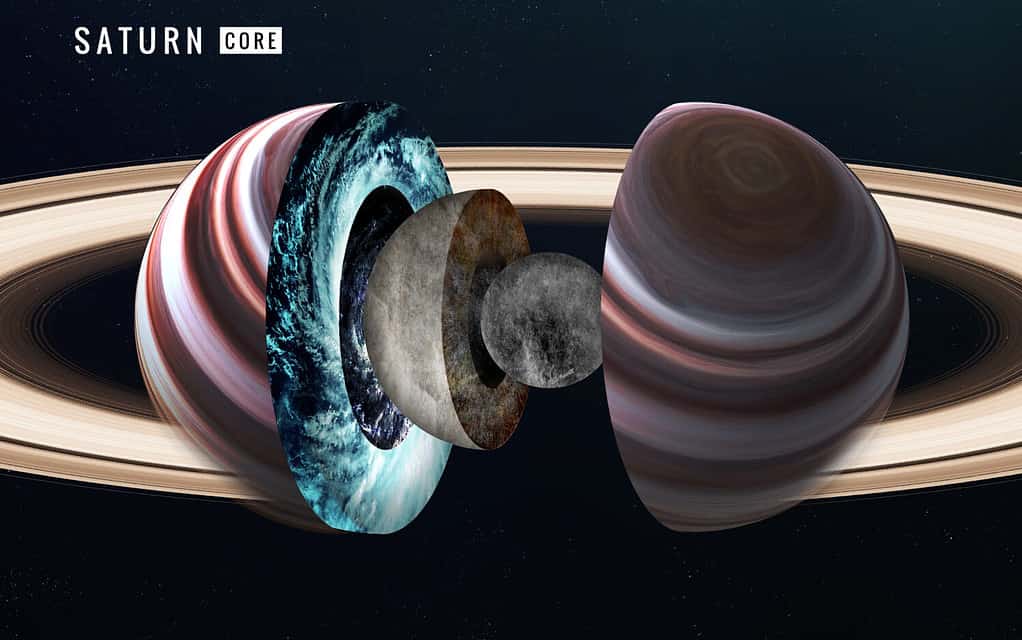
The interior of Saturn includes a rocky core and layers of metallic, liquid, and gaseous hydrogen and helium under high pressure.
©Vadim Sadovski/Shutterstock.com
Voyages to Saturn
Several spacecraft have been able to photograph Saturn close up. Three of these, Pioneer 11 and Voyagers 1 and 2, were just flybys, in which the spacecraft took pictures as they sling-shotted past the planet to get a gravity boost and speed up for their next destinations. The Cassini mission, though, was dedicated to Saturn and orbited it from 2004-2017 doing more in-depth science. When its mission was complete, this two-ton spacecraft was intentionally directed to crash into the planet and incinerated in its atmosphere. This not only provided valuable data about Saturn’s atmosphere as the spacecraft descended but also prevented leaving behind space junk or potentially contaminating one of Saturn’s moons or its rings with invasive bacteria from Earth.
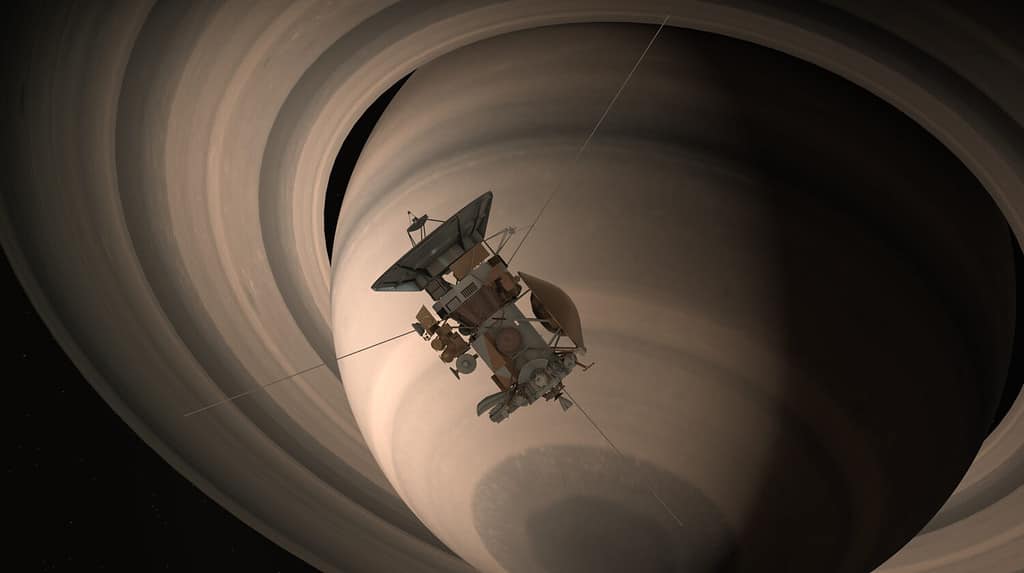
The Cassini probe returned a great deal of valuable data on Saturn up until it was intentionally crashed into the planet to burn up.
©Merlin74/Shutterstock.com
Future Exploration
In 2026 NASA plans to launch its Dragonfly mission, which will arrive at Saturn’s moon Titan in 2034. It will do an in-depth study and collect samples of this celestial body, which is thought to have promising conditions for the existence of life. What do you imagine life might look like there? Would it just be microscopic bacteria we can’t see with the naked eye? And if so, will scientists and artists publish pictures of it in so many different colors, we’ll have no idea what it will look like? Our bet is that the true color of microscopic Saturn-system life will be yellowish-brown, just like the planet.
The photo featured at the top of this post is © Vadim Sadovski/Shutterstock.com
Thank you for reading! Have some feedback for us? Contact the AZ Animals editorial team.






